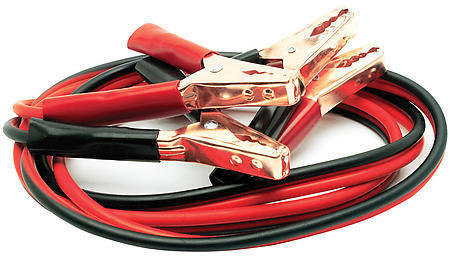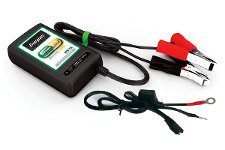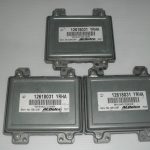Car batteries can go dead for all sorts of reasons. The battery can discharge if it’s not used, your vehicle’s numerous electronics can slowly draw the battery down, serious vibration caused by driving on washboard roads can literally break the battery’s internal components, etc.

What’s more, even if your battery isn’t completely dead, a weak battery – weak because you forgot to turn off your dome light – can be just about as useless as a dead battery. Cold weather is a factor too – if you live at high altitude and/or in a Northern climate, extremely cold temps can weaken your battery.
Whatever the cause, when your battery is dead or very weak, you’re not going anywhere…which means it’s time for a jump start. Here’s how you go about it:
1. Diagnose the Issue. When you try to start your car, listen very carefully to the sound your car is making. If the engine starts before quitting, it’s generally not the battery. If you turn the key in the ignition and nothing happens – or if the starting sound seems to be moving in slow motion – it’s usually a safe bet that the battery is weak or almost dead.
NOTE: It’s never a bad idea to try and jump-start a car that won’t start on it’s own. If nothing else, a jump-start attempt can rule out the battery as the cause of your problem.
2. Get some cables. Now that you know the battery is weak or dead, locate a pair of jumper cables and a vehicle to hook them to.

While it’s not a good time to tell you now, it’s a good idea to carry a pair of jumper cables in your vehicle at all times.
3. Get positioned. Since there are no “standard” battery placements, it’s often the case that your car and the car that’s giving you a jump have batteries on opposite sides of the engine compartment. Therefore, it’s a good idea to pop the hood on the jumping car, see where the battery is, then co-ordinate with the driver on where they should pull up.
4. Safety first. While you can hook a running car directly up to a dead car, the chances of causing damage to the jumping vehicle are lower when the ignition is off. Therefore, it’s best to get the jumping car in position, then shut it down and remove the key for a moment. You should make sure that the ignition in your car is off too.
5. Hook em’ up. Locate the positive “+” and negative “-” marks on the good battery. In newer vehicles, the positive battery post usually has a red cover that fits over it and the connecting wires.
Attach the red side of the jumper cable to the positive battery post on the good battery. Take the opposite red side of the jumper cable and attach it to the positive battery post on the dead battery.
Repeat the process with the black side of the jumper cable. Connect the black side of the jumper cable to the negative battery post on the good battery. However, do not attach the black side of the jumper cable to the battery post on the dead battery. Instead, attach the black jumper cable to a clean unpainted metal surface on the car with the dead battery. The engine block, a portion of the exposed metal frame, or even a small head of a raised bolt will suffice.
6. Let the jumper warm-up. Start the car with the good battery and then let it run for 2-3 minutes. This way, you’re building a little charge in the dead vehicle’s battery, which can be very helpful if the battery in the jumping vehicle isn’t quite powerful enough to get you started on it’s own (a common problem when cars are used to jump-start large SUVs or pickups).
7. Fire it up. Finally – the moment you’ve been waiting for. Crank up your car.
If the engine doesn’t start after a couple attempts, try waiting for 5-10 minutes before trying again. This will charge your battery, as the jumper’s vehicle likely isn’t powerful enough to get you going. Now is also a good time to make sure all your connections are solid (just check them one at a time).
It’s also sometimes helpful for the jumping vehicle’s driver to rev their engine while you’re trying to start. If they can hold their RPMs at 2000 or so, that will give your jump a boost.
8. Pack it up. First, whatever you do, don’t shut off either vehicle. The jumper’s car is going to need time to recharge, and your car’s battery isn’t going to be recharged for at least 20 minutes and perhaps as much as an hour (if your battery will recharge at all).
Next, disconnect the jumper cables from both batteries, start with the black (ground) side first. Note that it does not actually matter which order your remove them in, but since it is possible for a short to occur if one of the red cables touch the car while the other cable is attached to a battery, it is usually best to just reverse the order in which you initially attached them.

9. Get your battery tested and/or replaced. If your vehicle battery was completely dead, odds are good you’re going to need a new battery, as most car batteries won’t survive a total discharge without permanent failure. Therefore, it’s best to head to your local shop or auto parts store where they can test the battery and sell you a replacement if you need it.
If you can’t replace the battery right away, it’s a good idea to try and recharge your battery. The best way is to hook-up a battery charger, but if you don’t have one of those available, you can try letting your vehicle’s engine run for 30 minutes to an hour (preferably while driving). That short charge time might give you just enough juice to get started again.
Guest author Frank James writes for several insurance sites. Find cheap Washington, D.C. car insurance quotes or compare Arkansas auto insurance rates online.




